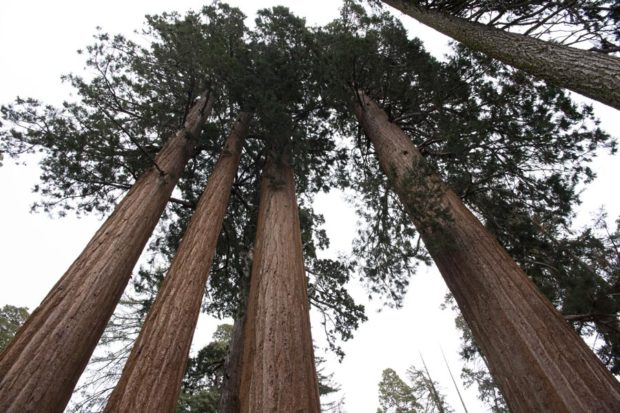
By Vic Bedoian
A new study of California’s Giant Sequoia groves shows the largest trees on earth are surviving effects of the most recent multiyear drought but are increasingly vulnerable to the continuing impacts of climate change. The research was done by scientists at Kings Canyon- Sequoia National Park, the Sierra Nevada Research Institute and the Chinese Academy of Sciences.
Giant sequoias are found only in 70 groves spread over 55 acres of the western slope of the Sierra Nevada, and for more than two and a half million years there they have survived dramatic variations in climate. Their resilience is in part because giant sequoia groves retain more moisture than surrounding forest areas. But the study found that following the latest drought, some of those groves are increasingly vulnerable to stress impacts.
Roger Bales, founding professor of engineering at UC Merced and director of the Sierra Nevada Research Institute that conducted the research, said that “the real takeaway from this research is that the forests in the southern Sierra overall are experiencing stress as the droughts come, and the droughts are hotter. Yet the giant sequoias are probably less susceptible to the drought impacts because they’re in areas that are preferentially wetter than the surrounding forest.”
Researchers measured what they’re calling the wetness and greenness of sequoia groves and the surrounding forest. They did this using data from moisture measuring instruments deployed throughout the Sierras and satellite photographs from 1985 to 2015.
Koren Nydick is the ecologist for Kings Canyon-Sequoia National Park. She says the loss of moisture during the drought was quite severe and reduced the natural subsurface water reservoir found in the groves. “The drying of the sequoia groves kind of erode that buffer,” she says, “or what we call a refugia against the effects of drought or the effects of climate change.”
Nydick found that the relatively greener forest detected in satellite photos indicates more profuse forest growth over the past 30 years. “If greenness is correlated to biomass, which it often is, that means biomass has been going up. And if biomass has been going up, that means that evapotranspiration has been going up. The more biomass there is, the more water the trees need to sustain it. Giant sequoias are like giant straws on the landscape.”
The thicker and more crowded the forest, the greater the biomass, the greater the transpiration and the bigger the draw on the forest’s subsurface water. Native Californians used fire to keep forest growth in check. But the influx of pioneers in the 1800s and increasing population in the mountains, followed by a policy of fire suppression by forest managers, resulted in a greener Sierra Nevada. Bales points out that “after a century of that, we have biomass densities, that is, the amount of wood and trees out there living, that is in some cases double what it was 100 to 150 years ago.”
Researchers also found that the last four years of the study period were characterized by the exceptional statewide drought that shrunk the groundwater reserves in giant sequoia groves. The scientists concluded that lower elevation groves are more at risk. That’s because groves higher up the mountains have the additional reservoir of snow melt to rely on.
Nydick says that some of the big trees are already showing the stress from that drought. “Proportionately, the groves experienced higher declines in wetness. That was the surprising thing. So, the sequoia groves are wetter to start out with, so they have more water to lose, and this study is telling us that they did lose more water.”
Bales indicates the giant sequoias came through the most recent dry years in good condition, and with scant mortality, but cautions that future droughts could hit them harder. “Fortunately, the giant sequoias are in an area where they had more water during this four-year drought, but when you project that drought to be a little bit longer, then some of them are going to suffer.”
Nydick fears more prolonged droughts could hit the big trees harder. “I see it as a longer-term situation, but we’re looking to the future because there will be more droughts and they’re likely to be hotter as time goes by.”
For Bales, the situation can be improved only with active and robust forest management. That includes thinning trees and brush and using prescribed fires. Forest managers in Kings Canyon and Sequoia have been doing just that in recent years for wildfire risk prevention and to reduce competition for groundwater.
“If we want to have the forest that will provide wildlife habitat, recreation, water supply and other services we’re going to have to manage them,” says Bales. “And the rest of the forest may be threatened from drought stress and wildfire more than the giant sequoia groves, but the giant sequoia groves are also at risk, and we can lower that risk.”
Finally, Bales points out that the water-holding capacity of giant sequoia groves and surrounding forest areas is also critical for downstream water users everywhere and that the key to the state’s water in the era of global warming might reside in the forests of the Sierra Nevada as a significant reservoir.
*****
Vic Bedoian is an independent radio and print journalist working on environmental justice and natural resources issues in the San Joaquin Valley. Contact him at vicbedoian@gmail.com.
